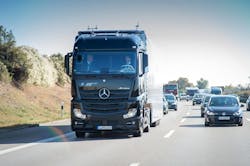What if no one is ready for self-driving vehicles?
My good friend and colleague Kevin Jones – editor of Fleet Owner’s brother publication, American Trucker magazine – penned an insightful blog post the other day, musing about the potential pushback against autonomous vehicles (AVs) in the wake of Tesla’s notorious autopilot failure back in May that killed a driver who literally wasn’t driving his self-guided vehicle when it slammed into (of all things) a tractor-trailer.
It’s interesting to also note that vehicle safety regulators are bluntly stating that this incident is not going to slow down their efforts to make AVs an everyday driving reality.
Indeed, it’s been fascinating for me to watch just how fast and hard the Obama administration, through the U.S. Department of Transportation, (DOT), is trying to speed up the AV development process largely for potential safety advantages – making them a key piece of a major technology investment push announced back in January.
Even state legislatures are jumping aboard the AV bandwagon, looking for ways to help spur more self-driving pilot tests – even for autonomous commercial vehicles.
But is everyone aside from the regulators, politicians, and vehicle engineers ready for the deployment of self-driving vehicles?
Maybe not, if the results of a recent survey conducted by Munich Reinsurance America (Munich Re) provide any guide.
Though the survey’s sample is rather small – it’s based on one-to-one interviews with 100 corporate risk managers attending the 2016 Risk and Insurance Management Society Conference (RIMS) back in April – the results are pretty startling, since these are the folks who guide the development of insurance policy details, especially where vehicles are concerned.
According to Munich Re, a majority (65%) of the risk managers polled said their companies have done nothing to prepare for the emergence of AVs in the automotive market.
Of those who have taken some form of action to prepare, just 23% are even discussing the ramifications of this “new technology” internally; only a mere 8% established a task force to deal with it, while a measly 4% created an operational plan to deal with them.
That’s more than a bit worrisome, since the regulatory pressure to roll AVs into the market is speeding up their development timeline. Indeed, according to global consultant McKinsey & Company, consumers will begin to adopt AVs starting in 2020 – with AVs poised to become the primary mode of transportation by 2050.
“It’s no longer a matter of if, but rather when the time will come for the wide-scale adoption of AVs,” noted Tony Kuczinski, Munich Re’s president and CEO, in a statement.
“The timeline for adoption may be sooner than many realize,” he stressed. “As such, it’s important for companies to start preparing now for how this technology could potentially impact their business, to both leverage opportunities and most effectively mitigate risks.”
Here are few more of Munich Re’s survey findings:
- When asked what they thought posed the greatest challenge to the widespread adoption of AVs, nearly half of the risk managers (41%) cited regulatory or legislative obstacles (which is strange, as both current and former regulators are really gung-ho about them) followed by safety (24%), security of technology (19%), cost (11%), and the ability to function in all weather and road conditions (5%).
- Security of AV technology is “top of mind” for risk managers, as the majority of survey respondents (55%) feel cyber security is the greatest insurance concern associated with AVs. This was followed by allocation of liability when autonomous/non-autonomous vehicles share roads (27%), economic disruption (7%), safety (7%), and the cost of technology to repair damaged vehicles (4%).
- From a cyber security perspective, respondents believe the greatest threats to AVs are auto theft by an unknown individual hacking into and overtaking vehicle data systems (42%) and the failure of smart road infrastructure technologies (36%).
“As AV technology progresses, the potential risk exposures and their implications for the insurance industry and society will continue to evolve,” Kuczinski emphasized. “Cyber security in particular is one area we are watching closely, as the vulnerability and implementation of safeguards for AVs remains to be seen.”
Munich Re crafted an insightful report regarding both the upside and downside to AVs, for while there are certainly some tantalizing benefits being touted for self-driving vehicles, there are a lot huge question marks as well – ones that existed well before the Tesla autopilot crash.
First the potential positives:
- According to the National Highway Traffic Safety Administration (NHTSA), driver error is the cause of 94% of accidents, so by reducing driver error via AV technology, we could significantly reduce the number of motor vehicle costs, the fatalities and injuries associated with them, and the costs, too.
- NHTSA estimated that some 35,322 vehicle crash fatalities occurred in the U.S. Thus, if human error is the primary cause in the bulk of those crashes, reducing if not eliminating that factor will save lives and reduce the “economic costs” of crashes in the bargain by as much as $1.9 trillion by 2025. (Hello!)
Yet the list of unanswered questions about self-driving vehicles remains quite long, too:
- How will AVs perform amongst a mix of autonomous and manually-operated vehicles?
- How will AVs impact people whose livelihoods depend on driving, like truck and taxi drivers?
- Will driving skills diminish and, if so, what will be the impact to road safety – if any?
- Who will be liable when an AV is involved in an accident? Will liability shift from driver to manufacturer as vehicle control shifts from human operator to autonomous systems? Or will accident–related liability exposure all but disappear?
- How will we manage cyber liability exposures that arise from the cameras, sensors, and computers integral to AV technology, or from vehicle–to–vehicle (V2V) and vehicle–to–infrastructure (V2I) systems?
In sum, making it a self-driving world may ultimately take longer and be a lot harder than many expect. We’ll see.

